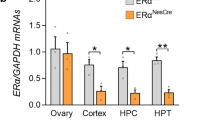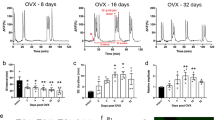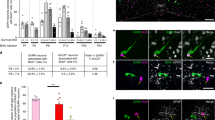Abstract
This study reports on the spatiotemporal dynamics of the expression of estrogen receptors (ERs) in the mouse central nervous system (CNS) during the early postnatal and the peripubertal period. At postnatal day 7 (P7), neurons with strong nuclear immunostaining for both ERα and ERβ1 were widely distributed throughout the brain. Sucrose density gradient sedimentation followed by western blotting supported the histochemical evidence for high levels of both ERs at P7. Over the following 2 days, there was a rapid downregulation of ERs. At P9, ERα expression was visible only in the hypothalamic area. Decline in ERβ1 expression was slower than that of ERα, and ERα-negative, ERβ1-positive cells were observed in the dentate gyrus and walls of third ventricle. Between P14 and P35, ERs were undetectable except for the hypothalamic area. As before P7, the ovary does not produce estrogen but does produce 5α-androstane-3β, 17β-diol (3βAdiol), an estrogenic metabolite of dihydrotestosterone, we examined the effects of high levels of 3βAdiol in the postnatal period. We used CYP7B1 knockout mice which cannot hydroxylate and inactivate 3βAdiol. The brains of these mice are abnormally large with reduced apoptosis. In the early postnatal period, there was 1-week delay in the timing of the reduction in ER expression in the brain. These data reveal that the time when ERs might be activated in the brain is limited to the first 8 postnatal days. In addition, the importance of aromatase has to be reconsidered as the alternative estrogen, 3βAdiol, is important in neuronal function in the postnatal brain.
This is a preview of subscription content, access via your institution
Access options
Subscribe to this journal
Receive 12 print issues and online access
$259.00 per year
only $21.58 per issue
Buy this article
- Purchase on Springer Link
- Instant access to full article PDF
Prices may be subject to local taxes which are calculated during checkout








Similar content being viewed by others
References
Arnold AP, Gorski RA . Gonadal steroid induction of structural sex differences in the central nervous system. Ann Rev Neurosci 1984; 7: 413–442.
Bakker J, Baum MJ . Role for estradiol in female-typical brain and behavioral sexual differentiation. Front Neuroendocrinol 2008; 29: 1–16.
Angold A, Costello EJ, Erkanli A, Worthman CM . Pubertal changes in hormone levels and depression in girls. Psychol Med 1999; 29: 1043–1053.
Eaton WW, Anthony JC, Gallo J, Cai G, Tien A, Romanoski A et al. Natural history of diagnostic interview schedule/DSM-IV major depression. The Baltimore epidemiologic catchment area follow-up. Arch Gen Psychiatry 1997; 54: 993–999.
Seeman MV . Psychopathology in women and men: focus on female hormones. Am J Psychiatry 1997; 154: 1641–1647.
Zsarnovszky A, Belcher SM . Identification of a developmental gradient of estrogen receptor expression and cellular localization in the developing and adult female rat primary somatosensory cortex. Brain Res Dev Brain Res 2001; 129: 39–46.
Perez SE, Chen EY, Mufson EJ . Distribution of estrogen receptor alpha and beta immunoreactive profiles in the postnatal rat brain. Brain Res Dev Brain Res 2003; 145: 117–139.
Kritzer MF . Regional, laminar and cellular distribution of immunoreactivity for ERbeta in the cerebral cortex of hormonally intact, postnatally developing male and female rats. Cereb Cortex 2006; 16: 1181–1192.
Gonzalez M, Cabrera-Socorro A, Perez-Garcia CG, Fraser JD, Lopez FJ, Alonso R et al. Distribution patterns of estrogen receptor alpha and beta in the human cortex and hippocampus during development and adulthood. J Comp Neurol 2007; 503: 790–802.
Kuiper GG, Enmark E, Pelto-Huikko M, Nilsson S, Gustafsson JA . Cloning of a novel receptor expressed in rat prostate and ovary. Proc Natl Acad Sci USA 1996; 93: 5925–5930.
Saji S, Jensen EV, Nilsson S, Rylander T, Warner M, Gustafsson JA . Estrogen receptors alpha and beta in the rodent mammary gland. Proc Natl Acad Sci USA 2000; 97: 337–342.
Li X, Schwartz PE, Rissman EF . Distribution of estrogen receptor-beta-like immunoreactivity in rat forebrain. Neuroendocrinology 1997; 66: 63–67.
Shughrue PJ, Merchenthaler I . Distribution of estrogen receptor beta immunoreactivity in the rat central nervous system. J Comp Neurol 2001; 436: 64–81.
Fan X, Warner M, Gustafsson JA . Estrogen receptor beta expression in the embryonic brain regulates development of calretinin-immunoreactive GABAergic interneurons. Proc Natl Acad Sci USA 2006; 103: 19338–19343.
Wang L, Andersson S, Warner M, Gustafsson JA . Morphological abnormalities in the brains of estrogen receptor beta knockout mice. Proc Natl Acad Sci USA 2001; 98: 2792–2796.
Wang L, Andersson S, Warner M, Gustafsson JA . Estrogen receptor (ER)beta knockout mice reveal a role for ERbeta in migration of cortical neurons in the developing brain. Proc Natl Acad Sci USA 2003; 100: 703–708.
Chu S, Fuller PJ . Identification of a splice variant of the rat estrogen receptor beta gene. Mol Cell Endocrinol 1997; 132: 195–199.
Lu B, Leygue E, Dotzlaw H, Murphy LJ, Murphy LC, Watson PH . Estrogen receptor-beta mRNA variants in human and murine tissues. Mol Cell Endocrinol 1998; 138: 199–203.
Maruyama K, Endoh H, Sasaki-Iwaoka H, Kanou H, Shimaya E, Hashimoto S et al. A novel isoform of rat estrogen receptor beta with 18 amino acid insertion in the ligand binding domain as a putative dominant negative regular of estrogen action. Biochem Biophys Res Commun 1998; 246: 142–147.
Hanstein B, Liu H, Yancisin MC, Brown M . Functional analysis of a novel estrogen receptor-beta isoform. Mol Endocrinol (Baltimore, Md) 1999; 13: 129–137.
Lu B, Leygue E, Dotzlaw H, Murphy LJ, Murphy LC . Functional characteristics of a novel murine estrogen receptor-beta isoform, estrogen receptor-beta 2. J Mol Endocrinol 2000; 25: 229–242.
Chung WC, Pak TR, Suzuki S, Pouliot WA, Andersen ME, Handa RJ . Detection and localization of an estrogen receptor beta splice variant protein (ERbeta2) in the adult female rat forebrain and midbrain regions. J Comp Neurol 2007; 505: 249–267.
Petersen DN, Tkalcevic GT, Koza-Taylor PH, Turi TG, Brown TA . Identification of estrogen receptor beta2, a functional variant of estrogen receptor beta expressed in normal rat tissues. Endocrinology 1998; 139: 1082–1092.
McEwen BS, Plapinger L, Chaptal C, Gerlach J, Wallach G . Role of fetoneonatal estrogen binding proteins in the associations of estrogen with neonatal brain cell nuclear receptors. Brain Res 1975; 96: 400–406.
Vannier B, Raynaud JP . Effect of estrogen plasma binding on sexual differentiation of the rat fetus. Mol Cell Endocrinol 1975; 3: 323–337.
George FW, Ojeda SR . Changes in aromatase activity in the rat brain during embryonic, neonatal, and infantile development. Endocrinology 1982; 111: 522–529.
Harada N, Yamada K . Ontogeny of aromatase messenger ribonucleic acid in mouse brain: fluorometrical quantitation by polymerase chain reaction. Endocrinology 1992; 131: 2306–2312.
Tena-Sempere M, Gonzalez LC, Pinilla L, Huhtaniemi I, Aguilar E . Neonatal imprinting and regulation of estrogen receptor alpha and beta mRNA expression by estrogen in the pituitary and hypothalamus of the male rat. Neuroendocrinology 2001; 73: 12–25.
Lemmen JG, Broekhof JL, Kuiper GG, Gustafsson JA, van der Saag PT, van der Burg B . Expression of estrogen receptor alpha and beta during mouse embryogenesis. Mech Develop 1999; 81: 163–167.
Dalla C, Antoniou K, Papadopoulou-Daifoti Z, Balthazart J, Bakker J . Male aromatase-knockout mice exhibit normal levels of activity, anxiety and ‘depressive-like’ symptomatology. Behav Brain Res 2005; 163: 186–193.
Vyazovskiy VV, Kopp C, Wigger E, Jones ME, Simpson ER, Tobler I . Sleep and rest regulation in young and old oestrogen-deficient female mice. J Neuroendocrinol 2006; 18: 567–576.
Eckstein B . The origin of 5alpha-androstane-3alpha, 17beta-diol and its 3beta epimer in peripheral blood of immature female rats. J Steroid Biochem 1974; 5: 577–580.
Eckstein B, Ravid R . On the mechanism of the onset of puberty: identification and pattern of 5 alpha-androstane-3 beta, 17 beta-diol and its 3 alpha epimer in peripheral blood of immature female rats. Endocrinology 1974; 94: 224–229.
Eckstein B . Studies on the mechanism of the onset of puberty in the female rat. J Steroid Biochem 1975; 6: 873–878.
Cochran RC, Schuetz AW, Ewing LL . Age-related changes in conversion of 5 alpha-androstan-17 beta-ol-3-one to 5 alpha-androstane-3 alpha,17 beta-diol and 5 alpha-androstane-3 beta,17 beta-diol by rat testicular cells in vitro. J Reprod Fertil 1979; 57: 143–147.
Luu-The V . Analysis and characteristics of multiple types of human 17beta-hydroxysteroid dehydrogenase. J Steroid Biochem Mol Biol 2001; 76: 143–151.
Steckelbroeck S, Jin Y, Gopishetty S, Oyesanmi B, Penning TM . Human cytosolic 3alpha-hydroxysteroid dehydrogenases of the aldo-keto reductase superfamily display significant 3beta-hydroxysteroid dehydrogenase activity: implications for steroid hormone metabolism and action. J Biol Chem 2004; 279: 10784–10795.
Liu H, Robert A, Luu-The V . Cloning and characterization of human form 2 type 7 17beta-hydroxysteroid dehydrogenase, a primarily 3beta-keto reductase and estrogen activating and androgen inactivating enzyme. J Steroid Biochem Mol Biol 2005; 94: 173–179.
Imamov O, Morani A, Shim GJ, Omoto Y, Thulin-Andersson C, Warner M et al. Estrogen receptor beta regulates epithelial cellular differentiation in the mouse ventral prostate. Proc Natl Acad Sci USA 2004; 101: 9375–9380.
Jensen EV, Suzuki T, Kawashima T, Stumpf WE, Jungblut PW, DeSombre ER . A two-step mechanism for the interaction of estradiol with rat uterus. Proc Natl Acad Sci USA 1968; 59: 632–638.
Weihua Z, Makela S, Andersson LC, Salmi S, Saji S, Webster JI et al. A role for estrogen receptor beta in the regulation of growth of the ventral prostate. Proc Natl Acad Sci USA 2001; 98: 6330–6335.
Barros RP, Machado UF, Warner M, Gustafsson JA . Muscle GLUT4 regulation by estrogen receptors ERbeta and ERalpha. Proc Natl Acad Sci USA 2006; 103: 1605–1608.
Morani A, Barros RP, Imamov O, Hultenby K, Arner A, Warner M et al. Lung dysfunction causes systemic hypoxia in estrogen receptor beta knockout (ERbeta−/−) mice. Proc Natl Acad Sci USA 2006; 103: 7165–7169.
Mitra SW, Hoskin E, Yudkovitz J, Pear L, Wilkinson HA, Hayashi S et al. Immunolocalization of estrogen receptor beta in the mouse brain: comparison with estrogen receptor alpha. Endocrinology 2003; 144: 2055–2067.
Nunez JL, Lauschke DM, Juraska JM . Cell death in the development of the posterior cortex in male and female rats. J Comp Neurol 2001; 436: 32–41.
Fontaine RH, Cases O, Lelievre V, Mesples B, Renauld JC, Loron G et al. IL-9/IL-9 receptor signaling selectively protects cortical neurons against developmental apoptosis. Cell Death Differ 2008; 15: 1542–1552.
Suzuki S, Brown CM, Dela Cruz CD, Yang E, Bridwell DA, Wise PM . Timing of estrogen therapy after ovariectomy dictates the efficacy of its neuroprotective and antiinflammatory actions. Proc Natl Acad Sci USA 2007; 104: 6013–6018.
Rossouw JE, Anderson GL, Prentice RL, LaCroix AZ, Kooperberg C, Stefanick ML et al. Risks and benefits of estrogen plus progestin in healthy postmenopausal women: principal results from the Women's Health Initiative randomized controlled trial. JAMA 2002; 288: 321–333.
Bean R, Seckl JR, Lathe R, Martin C . Ontogeny of the neurosteroid enzyme Cyp7b in the mouse. Mol Cell Endocrinol 2001; 174: 137–144.
Krieglstein K, Richter S, Farkas L, Schuster N, Dunker N, Oppenheim RW et al. Reduction of endogenous transforming growth factors beta prevents ontogenetic neuron death. Nature Neurosci 2000; 3: 1085–1090.
Weihua Z, Lathe R, Warner M, Gustafsson JA . An endocrine pathway in the prostate, ERbeta, AR, 5alpha-androstane-3beta,17beta-diol, and CYP7B1, regulates prostate growth. Proc Natl Acad Sci USA 2002; 99: 13589–13594.
Omoto Y, Lathe R, Warner M, Gustafsson JA . Early onset of puberty and early ovarian failure in CYP7B1 knockout mice. Proc Natl Acad Sci USA 2005; 102: 2814–2819.
Pardo CA, Eberhart CG . The neurobiology of autism. Brain Pathol (Zurich, Switzerland) 2007; 17: 434–447.
Lecourtier L, Kelly PH . A conductor hidden in the orchestra? Role of the habenular complex in monoamine transmission and cognition. Neurosci Biobehav Rev 2007; 31: 658–672.
Acknowledgements
The excellent technical participation of Christina Thulin-Andersson and Makbule Sagici is gratefully acknowledged. This study was supported by Study Abroad Support from Shinshu University School of Medicine, Study Abroad Support from Mochida Memorial Foundation for Medical and Pharmaceutical Research, the Swedish Cancer Fund, the EU Integrated Project CRESCENDO, and KaroBio AB.
Author information
Authors and Affiliations
Corresponding author
Additional information
Conflict of interest
Jan-Åke Gustafsson is shareholder and consultant of KaroBio AB.
Rights and permissions
About this article
Cite this article
Sugiyama, N., Andersson, S., Lathe, R. et al. Spatiotemporal dynamics of the expression of estrogen receptors in the postnatal mouse brain. Mol Psychiatry 14, 223–232 (2009). https://doi.org/10.1038/mp.2008.118
Received:
Revised:
Accepted:
Published:
Issue Date:
DOI: https://doi.org/10.1038/mp.2008.118
Keywords
This article is cited by
-
Novel oestrogen receptor β-selective ligand reduces obesity and depressive-like behaviour in ovariectomized mice
Scientific Reports (2017)
-
Sex differences in the serum level of endogenous ligands for estrogen receptor β in the elderly population
Scientific Reports (2016)
-
Involvement of estrogen receptor β in maintenance of serotonergic neurons of the dorsal raphe
Molecular Psychiatry (2013)
-
Review: magnetic resonance imaging of male/female differences in human adolescent brain anatomy
Biology of Sex Differences (2012)
-
Regulation of estrogen receptor beta activity and implications in health and disease
Cellular and Molecular Life Sciences (2009)



